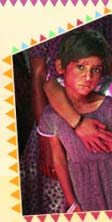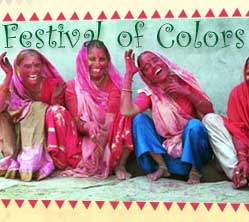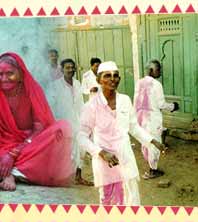Besides the Holi of Braj in Uttar Pradesh and Basant
Utsab at Shantiniketan in Bengal, the festival is celebrated with great
gusto in all the other states of India. In North India, Haryana,
Maharashtra and Ahmedabad
in Gujarat, a pot of buttermilk is hung high on the streets and young
boys try to reach it and break it by making human pyramids while the
girls try to stop them by throwing colored water on them to commemorate
the pranks of Krishna and cowherd boys to steal butter and 'gopis'
trying to stop them. At this time the men soaked with colors go out in
large procession to mock alert people of the Krishna who might come to
steal butter in their homes. The boy who finally manages to break the
pot is crowned the Holi King of the Year for that community.
At some places, there is a custom in the undivided Hindu families that
the women of the families beat their brother-in-law with her sari rolled
up into a rope in a mock rage as they try to drench them with colors and
in turn the brother-in-law bring sweetmeats for her in the evening.
Bengalis celebrate Holi as Dol Yatra or the swing festival where the
idols of Krishna and Radha are placed on swings and women sing
devotional songs, throw colors and 'abir' on them and perform dances as
devotees take turns to swing them. The people of Orissa celebrate Holi
in a similar manner but here the idols of Jagannath, the deity of the
Jagannath Temple of Puri, replace the idols of Krishna and Radha.
Manipuris in northeastern part of India celebrate Holi for six days.
Introduced in the eighteenth century with Vaishnavism, it soon merged
with the centuries-old festival of Yaosang. Traditionally, youths at
night perform a group folk dance called 'thaabal chongba' on the full
moon night of Phalgun along with folk songs and rhythmic beats of the
indigenous drum. However, this moonlight party now has modern bands and
fluorescent lamps and a bonfire of a thatched hut of hay and twigs is
arranged. Boys have to pay money to the girls for playing 'gulal' with
them. In Krishna temples, devotees sing devotional songs, perform dances
and play 'gulal' wearing traditional white and yellow turbans. On the
last day of the festival, large processions are taken out to the main
Krishna temple near Imphal where several cultural programs are
organized.
Visit our sponsors: India Tours









